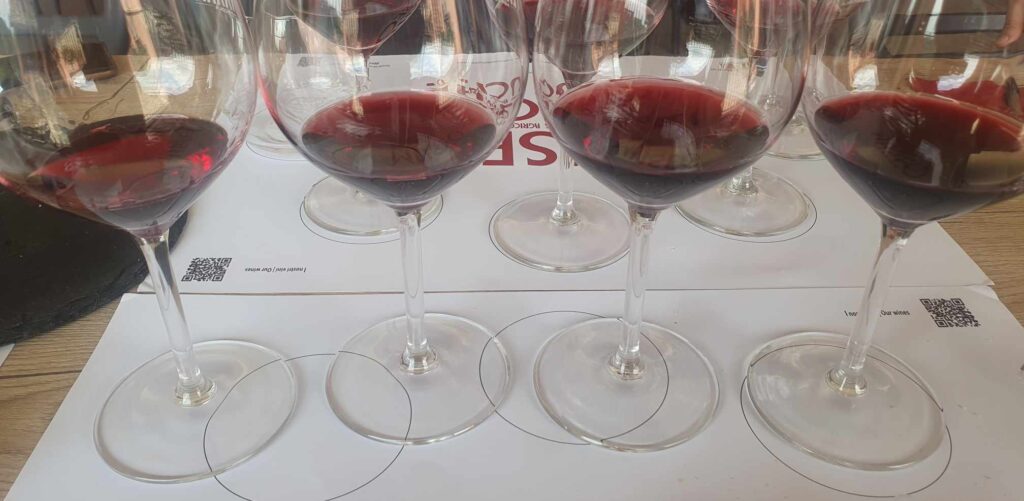On July 6th I was in Castagnole, Monferrato. To do what? Wine tasting, as alwasy.


To the east of Monferrato is Colli Tortonesi, where the white wine Timorasso mentioned in one of my latest articles hails from), and to the west is Le Langhe, the home to Barolo. The connected soil can only mean that Monferrato produces good wines too. The specialty here is Ruchè the red wine.
My first Ruchè
The first time I tasted a Ruchè was back in October 2022 at a little restaurant in Piemonte. Till then I’d never heard of this grape or wine. Back then my knowledge about Italian wines was gained either from my WSET study or from those sold at Fontanafredda, where I worked at that point. Since neither WSET nor Fontanafredda mentioned anything about Ruchè, I wouldn’t have known.
Red berry and pepper, the Ruchè I first tasted reminded me somehow of Pinot Noir.
On July 6th before setting off for Monferrato, I took a peek at Wine Grapes. About Ruchè, it said “low acidity”. As I remembered, that Ruchè I’d tasted back in October 2022 was delicious and I’d always related delicious wine to high acididy. So I just reckoned the book had made a mistake.
From City to Vineyard
The great-grandfather of the owner of the winery in Castagnole I visited had gone to the US during the gold rush era. He did dig some gold and returned home happily, and later bought this land on which today’s winery is built. The grandfather took over the vineyard and continued to work there. But later the father chose office work over farming. He moved to Turin, the capital of Piemonte, to work for Fiat.
During his childhood, every weekend the owner would go back to the countryside from Turin with his father. He would play in the vineyards and help crush the harvested grapes with his rain-booted feet. Those experiences planted seeds in his heart. When he grew up, he returned to Castagnole to grow grapes and make wine, despite his father’s objections.

The Ruchè used to be a table grape or made into a wine blended with other varieties. In the 1960s, when a priest named Don Giacomo Cauda came to Castagnole, he tasted Ruchè and recognised its potential for varietal wines. As the chapel happened to have a few long-abandoned vineyards, Father Cauda started planting Ruchè. It is thanks to Father Cauda’s initiative that Ruchè di Castagnole Monferrato, a DOCG wine region dedicated to the Ruchè red wines, exists today.
Low acidity is good too
This “gold rush” winery produces a good range of Ruchè, from steel vat to barrel-matured, from multi-vineyard blends to single-vineyard. I got to taste them all that day.
The Ruchè matured briefly in the steel vat had a raspberry and pepper flavour. During the tasting, I paid special attention to the acidity, which was indeed quite low. What amazed me was even the acidity was low, the wine was in good balance and so delicious. Ruchè’s abv is at least 14. Theoretically, a higher abv like this needs a firmer acidity support to feel more uplifting and enjoyable. But the high alcohol and low acidity worked just perfectly in the Ruchè, a 180° reversal of the wine-tasting theory.

The Ruchè matured in large oak barrels for six months, followed by three months in bottle, was smoky, rosy and peppery.
The old vine Ruchè, matured in 80% steel casks, 20% in 500-litre oak barrels for 9 months, then bottled matured for 6 months, had a profile of cherry, kirsch and pepper.
The Ruchè Riserva, matured in medium-sized oak barrels for 12 months and then bottled for 12 months, boasted notes of candied plum, liquorice, balsam and pepper.
The tannins of all four wines were slightly grainy yet very smooth.
After the tasting, the owner’s wife told me the unique pepperiness was actually a sign of high quality tannins.
Each of the four Ruchès had its own characteristics. I was most impressed with the Riserva. Intriguing, complex, low in acidity but with a juiciness similar to that of Sangiovese; high in alcohol but in the meantime utterly elegant like Timorasso. I stole a few more sips just before leaving the tasting room.
They say wines of Le Langhe are wonderful, but recently, east of Le Langhe, I’ve tasted equally wonderful Timorasso and Ruchè, both were Italy’s native, little known varieties/wines.
I like how Colli tortonesi and Monferrato are less touristic and more authentic than Le Langhe, but what I love the most is that they’re geographically closer to Milan than Le Langhe. Translation: a good sip of Timorasso or Ruchè is always just around my corner.

